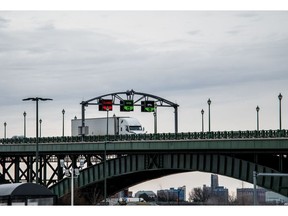
Article content
(Bloomberg) — Canada has effectively suspended almost all of its retaliatory tariffs on US products, tamping down inflation risks and improving its growth outlook, according to Oxford Economics.
THIS CONTENT IS RESERVED FOR SUBSCRIBERS ONLY
Subscribe now to read the latest news in your city and across Canada.
- Exclusive articles from Barbara Shecter, Joe O'Connor, Gabriel Friedman, and others.
- Daily content from Financial Times, the world's leading global business publication.
- Unlimited online access to read articles from Financial Post, National Post and 15 news sites across Canada with one account.
- National Post ePaper, an electronic replica of the print edition to view on any device, share and comment on.
- Daily puzzles, including the New York Times Crossword.
SUBSCRIBE TO UNLOCK MORE ARTICLES
Subscribe now to read the latest news in your city and across Canada.
- Exclusive articles from Barbara Shecter, Joe O'Connor, Gabriel Friedman and others.
- Daily content from Financial Times, the world's leading global business publication.
- Unlimited online access to read articles from Financial Post, National Post and 15 news sites across Canada with one account.
- National Post ePaper, an electronic replica of the print edition to view on any device, share and comment on.
- Daily puzzles, including the New York Times Crossword.
REGISTER / SIGN IN TO UNLOCK MORE ARTICLES
Create an account or sign in to continue with your reading experience.
- Access articles from across Canada with one account.
- Share your thoughts and join the conversation in the comments.
- Enjoy additional articles per month.
- Get email updates from your favourite authors.
THIS ARTICLE IS FREE TO READ REGISTER TO UNLOCK.
Create an account or sign in to continue with your reading experience.
- Access articles from across Canada with one account
- Share your thoughts and join the conversation in the comments
- Enjoy additional articles per month
- Get email updates from your favourite authors
Sign In or Create an Account
or
Article content
Article content
The government imposed new import taxes of 25% on about C$60 billion ($43 billion) of US-made goods in March in response to the first round of tariffs from the Trump administration. Canada also retaliated against US auto tariffs in early April by putting its own levies on US vehicles.
Article content
Article content
But Prime Minister Mark Carney’s government then announced a six-month tariff exemption for products used in Canadian manufacturing, processing and food and beverage packaging, and for items related to health care, public safety and national security. Automakers got a break, too: companies that manufacture in Canada, such as General Motors Co., are allowed to import some vehicles into Canada tariff-free.
Article content
By signing up you consent to receive the above newsletter from Postmedia Network Inc.
Article content
Those exemptions mean Canada’s tariff-rate increase on the US is “nearly zero,” according to calculations by Oxford.
Article content
“It’s a very strategic approach from a new prime minister to really say, ‘We’re not going to have a retaliation,’” Tony Stillo, Oxford’s director of Canada economics, said in an interview. “It’s a strategic play on the government’s part to not damage the Canadian economy.”
Article content
Retaliatory tariffs on some US goods remain, including on food items such as orange juice, alcohol and coffee, as well as clothing and cosmetics.
Article content
Carney fought and won an election last month by convincing millions of Canadian voters that he was the best candidate to handle a trade war with the US, which buys about three-quarters of Canada’s exports.
Article content
Article content
The prime minister said Canada will have to strengthen its own domestic economy — partly through government-backed infrastructure and housing initiatives — and seek out new trade and security alliances with other countries. But he’s also made it clear that he doesn’t necessarily endorse “dollar for dollar” retaliation, which former Prime Minister Justin Trudeau said he supported in “principle.”
Article content
A spokesperson for Finance Minister Francois-Philippe Champagne, whose department is responsible for administering the tariffs, did not reply to a request for comment on the Oxford report.
Article content
Oxford still sees the Canadian economy slipping into recession this year, but it upgraded its growth forecast to 0.9% for this year and 0.3% next year. Government spending should soften the blow of the trade war, the firm said. It’s forecasting that the rate of inflation will briefly rise to 3% in 2026, but should quickly ease.
Article content

.jpg) 4 hours ago
1
4 hours ago
1
 English (US)
English (US)